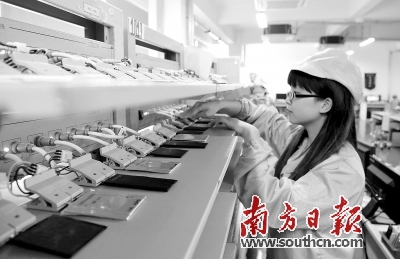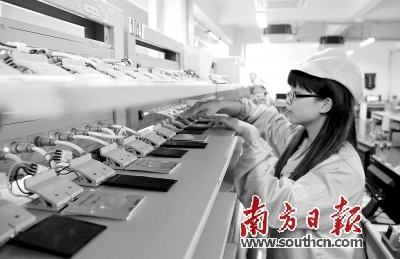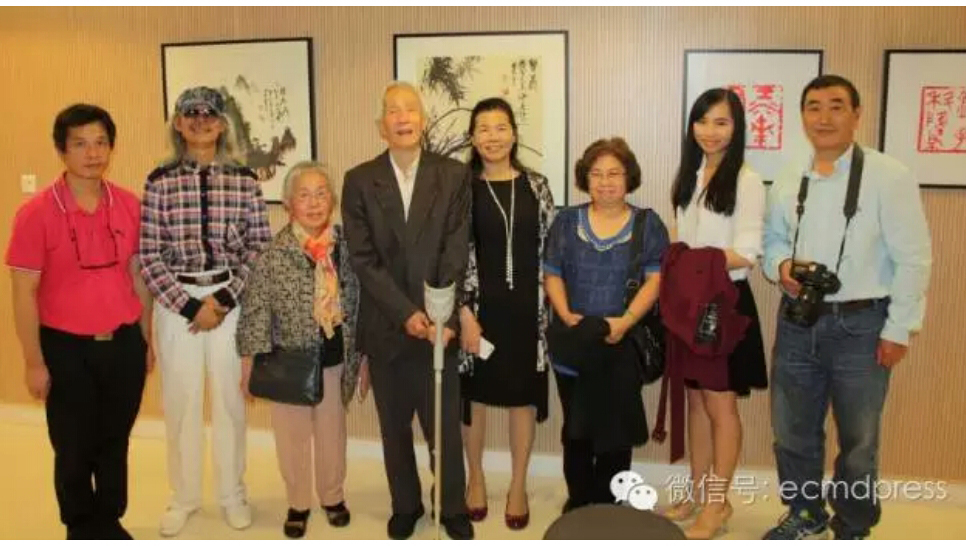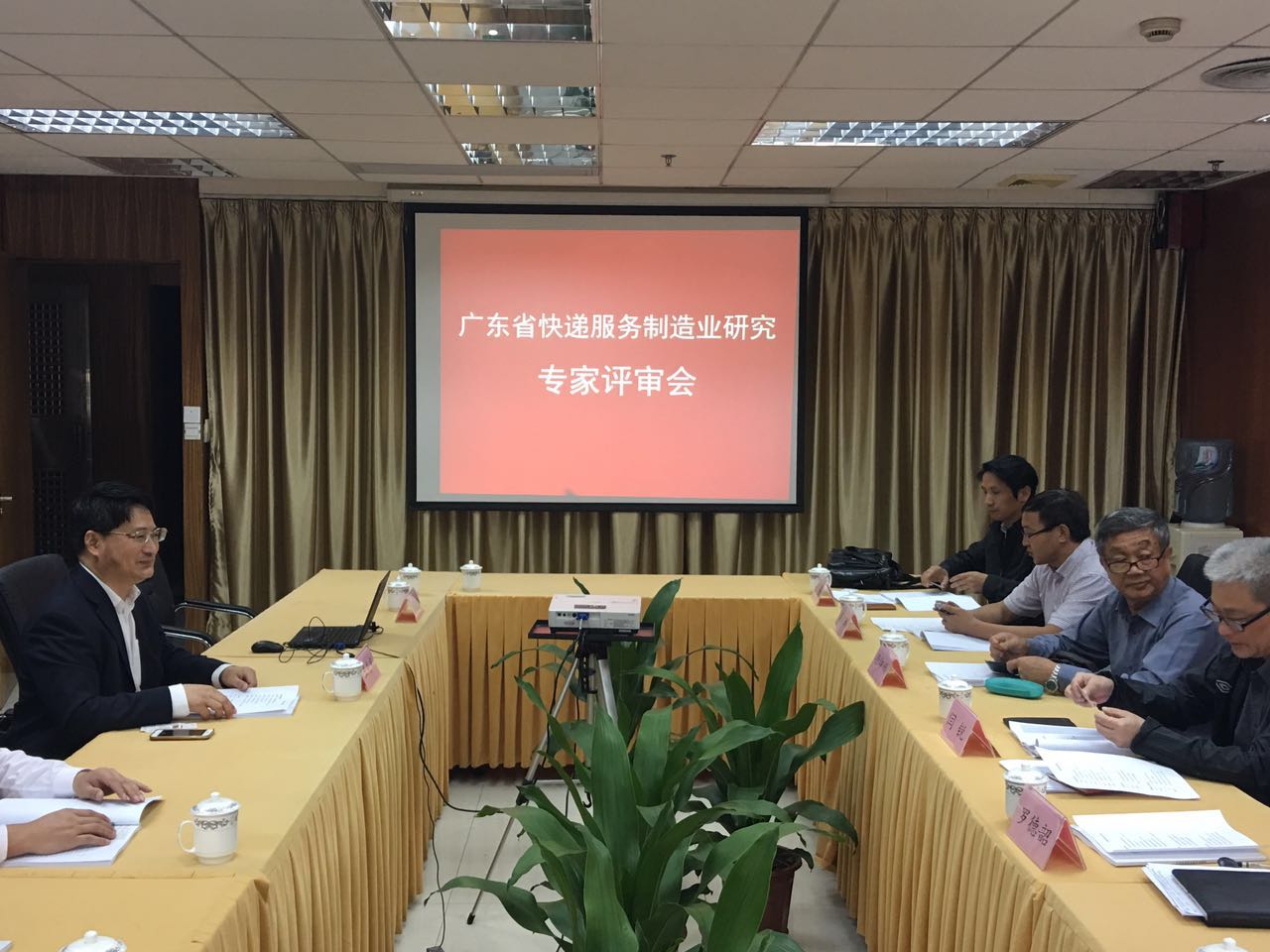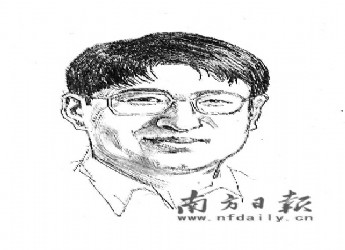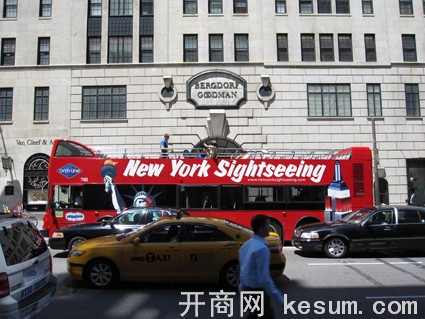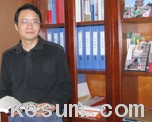The Alluring China Market
Despite the adoption of prudent economic policies since the early 90s, China's economy has been able to grow fast. Its average annual economic growth rate of 11.7% from 1991-1994 was the highest among the major economies of the world. Partly owing to the strict financial control policy, the country's economy slowed slightly in 1995, but still achieved an annual growth rate of 10% and total retail sales also grew at a similar rate. This rapid economic growth has made China an attractive market to foreign companies.
International marketers frequently mention that the greatest obstacle to marketing in China is the country's domestic distribution system, which has long been characterized as complex, rigid, inefficient, regionally-isolated and production-driven. This ministry-based, multi-layered and horizontally disconnected distribution system, in concert with import duties and non-tariff barriers, once made China a non-accessible market.
A series of reform programs has drastically changed the country's entire distribution system and, consequently, has instituted a new pattern of marketing channels. Although China remains different in many ways from Western markets, the significant improvement in the capacity of its marketing distribution system is evident in the acceptance and growth of new forms of retailing and wholesaling. This will definitely create more business opportunities and a more favorable environment for aggressive international traders. However, many international marketers have been bewildered by the complexity and variety of the distribution system in China, and are unsure about which marketing channels are capable of effectively getting their products to the Chinese market. How to circumvent China's distribution system becomes the key challenge to international marketers who try to get a foothold in this alluring market.
In fact, the experience of pioneering China traders shows that a major reason for their failure was their unfamiliarity with the country's domestic distribution system. For instance, some traders did not know how their products reached their final customers and were therefore unable to assess and control local distributors. This highlights the need to explore the characteristics of China's marketing channel system.
Traditionally wholesalers have played a prominent role in China's centralized distribution system and have long been entrusted with major responsibility for carrying out the state plan. In the course of reforming the country's marketing distribution system, a large number of wholesalers of various types of ownership has emerged. In 1994, the number of wholesale establishments per 1000 inhabitants in Japan was about 3.6, in the U.S.A. and Europe it was 1.6,1 com pared to approximately 1.1 per 1000 inhabitants in China. If China will follow a similar path to develop its wholesale channels, there will still be much room for it to grow and consequently more opportunities for foreign enterprises who have long been waiting to enter this vast market. Therefore, instead of describing the whole distribution system, this study only focuses on the wholesale sector in China. Its major objectives are to provide an overview of a series of reforms in the wholesale sector, highlight the prominent features of the existing wholesale systems for consumer and industrial products, compare the strengths, weaknesses and productivity of different types of wholesaler and identify the trends of the reform and unresolved channel management issues. It also investigates from a management perspective if such alterations will call for a different marketing emphasis. It is hoped that the study will provide insightful information for the formulation of channel strategy to facilitate entry into the Chinese market.
This article is written on the basis of qualitative information gathered from the following sources. We interviewed twenty-five government officials from the Bureau of Commerce, the Economic Planning Commission and the Finance Offices in Guangzhou, Shanghai, Beijing and Wuhan. We asked them to identify the key characteristics of China's wholesale system and the trends that would shape the course of reform in this sector. One of the authors is the training co-ordinator of the China Business Centre at the Hong Kong Polytechnic University. Since 1994 the center has provided marketing management training programs to more than 1200 business executives from mainland China and 400 middle and senior China trade managers from Hong Kong. Marketing in China was a core subject in some of these management training programs and during class discussions managers and executives were encouraged to report their experiences of marketing products in China and to identify the specific marketing and management issues that had threatened or would impede the growth of their business there. We have also conducted several distribution management consultancy projects for local and multinational firms in China since 1990. This experience helps us to understand the practical marketing problems presented by China's wholesale system.
The Wholesale System Under the Centrally-Planned Economy
Under the centrally-planned economy China had a three-tier distribution system which was dominated by a massive, nation-wide wholesale network. Before 1986, as much as 80% of all goods in China were distributed through various state-owned marketing channels. Within this distribution system, all wholesale businesses were state-owned enterprises operating at three administrative levels.
1. The first-tier consisted of 59 national wholesale centres in Tianjin, Shanghai and Guangzhou. These first level wholesalers acted as general control agents responsible for primary national or regional distribution.
2. Provincial wholesale centres were the second tier. Their number had reached 1400 centres prior to the reform in the wholesale sector. Second-tier wholesalers were responsible for provincial or major urban distribution.
3. The third-tier wholesalers administered local distribution centres and dispatched goods to retailers within their areas.
The traditional three-tier distribution system was operated by a top-down approach in the allocation of production and distribution quotas according to the central government's mandatory plan. As shown in Figs 1 and 2, the State Planning Commission set over ail production goals for factories and collected the outputs from them. For consumer goods, the outputs would first be delivered to and stored at national (first-tier) distribution centres, which were managed by the Ministry of Commerce in Tianjin. For raw materials and industrial goods, similar activities would be controlled and co-ordinated by the Ministry of Material Management. Goods were then despatched to numerous second and third-tier distribution centres at both regional and local levels. Local state-owned wholesalers thus served as intermediaries between the producers and the retail outlets. They had to store products and transport them to local retailers. The logistical arrangements were built around wholesalers to assure the accomplishment of the economic goals set by the central government and the major activities of wholesalers were by and large restricted to warehousing and delivery of goods.
In addition, the central government firmly insisted that wholesale activities had to comply with the "3fixed policy": (a) the relationships between wholesalers at different administration levels were fixed; (b) the supplies allocated to each wholesale center were fixed and retailers at local provinces were required to buy all their merchandises from the assigned wholesalers regardless of the quality or range of the available products; and (c) the wholesale prices of all products were fixed by the government.
Under this rigid structure and inflexible mode of operation, inability to respond to changing market needs, showing no concern for value-added activities, paying limited attention to logistics, havin8 no control over the growth direction of wholesale business and being unable to view the business as a market oriented exercise, all conspired to encumber the circulation of goods. A few years after the adoption of the economic open door policy, the central government soon observed that the limited marketing functions performed by state-owned wholesale enterprises were apparently incompatible with the requirements of the development of a market economy. In particular, the emergence of enormous numbers of collectively owned and private retailers in the wake of the economic reform imposed serious competitive pressure on state-owned wholesalers and retailers. The former was frequently blamed for failure in providing the necessary marketing and logistics services to the latter and was therefore viewed as the bottleneck in the whole distribution process. This called for reforms in the wholesale sector.
The Reform in the Wholesale Sector
In retrospect, the reform in China's wholesale distribution system can be separated four phases.
Phase I: Relaxation vs Regulation (I980-83) The central objective of the economic open door policy is to invigorate national economy by granting autonomy to enterprises of different types to run their own business. A significant response to this policy from the wholesale sector was the cancellation of the "3-fixed policy", which in effect allowed wholesalers greater freedom in selling and purchasing products and helped to streamline wholesale operation at different administration levels.
Another favorable change was to reduce the level of control over wholesalers. The central government declared it would (a) only retain control over wholesale operation for a small number of commodities that were important to daily living and certain industries, (b) maintain control over a certain number of key wholesalers instead of controlling the whole wholesale network or all existing state-owned wholesale enterprises.
Relaxation of control over state-owned wholesalers' business activities immediately motivated them to try all possible means to operate their business for greater profits, some being legally or ethically unacceptable. Predictably, this type of practice would lead to disorder in the wholesale sector. Therefore, in February 1983 the first set of Wholesale Market Management Regulations--"Trading Regulations for Collective Markets in sub-urban areas and township"—was promulgated. These regulations defined the legally acceptable practice on taxation, pricing behavior, security and hygiene requirements. Later, in order to regulate and manage wholesale activities more effectively, the "General Guidelines on the Management of Collective Markets" were introduced by the State Administration Office of Industry and Commerce.
Phase II: Creation of New Wholesale Channels (1983-86)
Although the initial reform in the wholesale sector commenced in the early 1980's, it was in this phase that the reform led to structural changes in the country's wholesale distribution system. In an attempt to revamp wholesale operation for industrial products, the PRC government introduced the "Chongqin model'' in 1983 which involved the construction of trade centres where both wholesalers and retailers could trade directly. The objectives were to shorten channel length and to introduce a new marketing channel which was open to all potential buyers. As government officials had high expectations of these new wholesale outlets, the number of district-level trade centres rapidly increased to around 400 by the end of 1988.2
Nevertheless, this transaction-based Chongqin model was soon criticized for ignoring market forces and providing inadequate and poor marketing and logistics services to facilitate transactions. As rapid economic development in China boosted the demand for raw material and industrial equipment, many trade centres, instead of providing supporting services, involved themselves in the wholesale trade. In many instances, the management office of the trade centre did not release the supplies to the assigned users but sold them to other users who would pay higher prices. Given their political connections with state-owned producers and their predominant position in the distribution channels, they could easily control and manipulate the supplies to maximize profit. This unhealthy practice forced most buyers to spend more time and money to find the required production materials they needed.
As the complaints against trade centres increased, the central government was forced to look into the matter and, consequently, adopt a more market-oriented concept to build new trade centres which would be able to provide a wide range of administrative and marketing support to wholesalers, including acting as an import/export agent for whole-salers, conducting marketing research, assisting in organizing trade shows, exhibitions and special public relations programs--and so on.
Phase III: Reliance on the Wholesale Market (1986-92)
In this phase the emphasis of the reform was on improving wholesale operations for various types of industrial, agricultural and consumer products. The most striking structural change was the emergence of many wholesale markets for these goods.
For a long time wholesale markets had been the major outlets for service buyers in rural areas, with a large number of retailers actively sourcing supplies from wholesalers. Seeing this trend and wishing to regulate the increasingly confused system of wholesale markets, the central government decided to expand the role of wholesale market in the country's distribution sector by setting up a national model for wholesale operations. The first national wholesale market--the Northern Wood and Timber wholesale market--was established in May 1992. It was open to different types of wholesalers and retailers, including those coming from overseas. The major objectives were to co-ordinate the supplies of wood and timber products and channel back to the central government the market information vital for the development of production plans,
Normally wholesale markets are supervised by the local Administration Office of Industry and Commerce which stresses that wholesale operations should conform to the "five unique points policy" unique leadership, a unique policy, centralization of the provision of supporting services, centralization of management, and a unique service fee. In practice, daily operation is managed by the Management Office which is formed by members from the Planning Commission, the Price Management Committee, the Taxation Office, Banks, The Statistics Bureau and the Finance Commission. The major functions of the Management Office are to:
1. Organize, co-ordinate and regulate wholesale activities,
2. Supervise and co-ordinate pricing activities, tax affairs, financial management support (e.g. credit arrangement) and compiling statistics.
In practice, it:
1. Centralizes transportation and logistics management activities to ensure efficiency in producing both space and place utility.
2. Accepts free price negotiations. Prices could be floating freely within the officially acceptable range. Any arguments on price issues are settled in favor of the producers' interests.
3. Introduces a membership system as a control mechanism. Non-member wholesalers are not permitted to trade there.
4. Adopts the Transaction Guarantee policy which enables the Management Office to compensate any possible losses arising from breach of contract and bankruptcy of individual members.
5. Allocates purchase quotas to individual members to control the production and supply of products.
Phase IV: Being Market-Oriented and Improving Competitive Strengths (1992 to Present)
During the economic adjustment period in the late 80's, wholesale business was by and large managed by state-owned wholesalers. The central government wanted to consolidate the dominant position of state-owned wholesale enterprises in marketing channels across various industries, regardless of the emergence of both collectively-owned wholesalers and private wholesale companies. However, it underestimated the influence of the country's booming retail trade, as the achievements of the distribution reform at the retail level brought in a large number of retail establishments which began to exert significant pressure on China's cumbersome wholesale network. In order to cope with this challenge for better functional integration between wholesalers and retailers, the central government has decided to expedite the reform of the wholesale sector. Major steps include:
A. Encouraging local governments to construct regional wholesale markets in urban and rural areas throughout China. The central government plans to develop up to 15 large scale wholesale centres in various cities, with five in Guangdong province and others in Shanghai. Several non-ferrous metals wholesale markets will also be built in Wuhan, Shanghai and northern China; a staple wholesale market in Zhengzhou; a coal wholesale market in Qinhuangdao; and a rubber wholesale market in Guangzhou.
B. Improving the competitiveness of state-owned wholesale enterprises. To accomplish this goal, the central government (a) ceases to use administrative methods to assign targets for the distribution of raw materials to the buyers, (b) increasingly relies on market-driven devices to distribute the required supplies to wholesalers, replacing the traditional buying-off method, and (c) allows wholesalers of all types to negotiate direct with manufacturers for the right to act as agents or distributors for their products.
C. Restructuring for a slim organization with greater productivity. The PRC government has pushed relentlessly the Reform of State-owned Enterprises policy since the early 90's. A number of poorly performing state-owned wholesale firms have been restructured by chopping off unprofitable divisions or subsidiaries and making them into shareholding companies. The major purpose of undertaking such changes is to ensure healthy operation, to streamline administration, to allow greater flexibility in managing business and to motivate state-owned wholesalers to be responsible for the profit and loss of their operations. Luoyang Glasses Manufactory and Supplies (LGMS) is a typical example of this policy. Originally this wholesale firm was owned and controlled by the Construction Material Bureau of Henan Province and its main activity was to produce and supply glass products to construction firms via a number of Construction Materials Supplies Co-operatives in different provinces. In 1995 LGMS was corporatized to become Luoyang Glasses Corporation which soon terminated the relationship, which by nature was administration-based, with many Construction Material Supplies units. Instead, this newly-formed corporation has opened its sales offices in 32 cities to look after its wholesale business and also set up branches in New Zealand, Australia, South Africa and Vietnam to handle its export activities.
Another example is Wuhan Industrial Products Commercial Corporation (WIPCC) which was formed in 1992. Fourteen of its subsidiaries were wholesale firms. Since its inception this corporation has suffered from two major problems: accumulated bad debts and great losses resulting from inefficient operation. However, in the course of restructuring WIPCC turned eight of its wholesale operations into seventeen independent firms. Eight of them manage the old firms' business, clearing the inventory and collecting receivables being the major activities, whereas the nine newly-formed firms have not only taken over the profitable wholesale businesses from the old firms but also seek and invest in new business opportunities. Over 88% of the corporation’s employees and 48% of the total assets were transferred to these nine newly formed companies. This restructuring program immediately produced positive effects. In 1995 the total sales turnover of these nine subsidiaries increased by 23.44% and earned a net profit of RMB 888.51 million. For the same period, the loss incurred by the remaining eight subsidiaries reduced by 23.70%.
D. Integrating for greater synergy. The opening of the wholesale sector is bound to bring into the country a number of foreign wholesale enterprises who, with significant cost advantage and overseas sourcing networks, might seriously threaten the survival of state-owned wholesalers. In order to protect state-owned wholesalers, the PRC government has recently introduced a membership system to maintain a close relationship between wholesalers and retailers and, on a trial basis, combine supply centres with chain shops and supermarkets for greater synergy. During the Ninth Five-Year Plan period (from 1996- 2000), the central government will further enlarge the scale of chain stores and encourage the formation of trans-regional chain stores on the basis of the regional networks. By the year 2000, China aims to have 1500 chain-store operators.4 Obviously, the development of chain stores or commercial conglomerates represents a kind of horizontal expansion that would lead to substantial economies of scale, putting state-owned wholesalers in a much stronger position to defend themselves.
E. Alternatively, reorganizing for greater proficiency in specialized areas. Specialization represents another significant change experienced by state-owned wholesalers controlled by provincial government. This type of wholesaler has traditionally administered and allocated a wide range of products to retailers and users. Common to their operations were the problems of poor division of labour and low level of computerization. The lack of division of labour in effect discouraged employees to work harder and earn more since the loss incurred by one product could be recovered by the profits generated by other products. Slow adoption of computerization consequently created several bottlenecks in disseminating information crucial for effective inventory and logistics management. One solution to overcome these problems is to re-organize this type of wholesale organization according to the principle of specialization. By doing so, the wholesale organization will become a wholesale corporation which operates a number of divisions or subsidiaries, each of which is specializing in managing a group of products belonging to the same category and responsible for its profit and loss. During the transformation process, outside investors are encouraged to become shareholders of the wholesale corporation or of its subsidiaries. For instance, in the early 90's Suzhou Material Bureau first set up the Suzhou Material Supplies Corporation (SMSC) with over ten investors, including China Textile Material Corporation, Hunlan Raw Material Company, The PRC Bank of Industry and Commerce, China Agriculture Trust, Shanghai Baogang, Qingyang Chemical Supplies Company etc. Then SMSC set up eighteen subsidiaries to handle different categories of goods and materials. Some of these subsidiaries are wholly-owned by SMSC, some are joint ventures and some are co-operative business operations. Such transformation ensures better integration with suppliers, allowing SMSC to provide more services to retailers, and to improve management efficiency and productivity. All these measures led to an increase of 20% of total sales revenue in the following year.
Types of Wholesalers
In line with the reforming process has been the sharp increase in the number of wholesale establishments. According to the Statistics Bureau of the PRC, in 1995 the total number of wholesale outlets in China increased to a record 1, 675, 156, 5 an increase of 17.3% compared to the previous year. Today, multiple wholesale channels are available to foreign companies manufacturing in or exporting to China and they can be classified as follows (Fig. 3): A. State-owned wholesalers at different administrative levels. State-owned wholesalers can be classified into four categories according to their positions in the administrative apparatus: (a) state-owned wholesalers under direct control of provincial government, (b) state-owned wholesalers controlled by district office, (c) state-owned wholesalers at county level, and (d) state-owned wholesalers affiliated with various ministerial systems. Their functions are to organize and co-ordinate wholesale and retail activities, to provide warehousing support and financial support in the form of credit sales and to serve as "reservoirs" to manage fluctuations in supply and demand. Normally state-owned wholesalers belonging to categories (a) and (d) are larger in terms of transaction size and number of employees and have ties with a large number of retailers, for instance, the wholesale enterprises under the Ministry of Electronic Industry had control over 2500 retailers in 1994.
In addition to the restructuring exercise, another recent change in the wholesale system is that in coastal cities and special economic zones many ministry based wholesalers have been dismantled to become independent wholesale corporations in order to achieve greater flexibility and autonomy in managing their business, As shown in Table 1, the reform process has created many new shareholding-based wholesaler firms. Employees working in this type of newly emerging wholesale firm are more productive than their counterparts working for non-shareholding state-owned wholesale enterprises, as measured by the average contribution to total sales turnover per employee (RMB 607400 vs RMB 378800) (Table 2) On average, their transaction volume was also much larger than that of non-shareholding state-owned and collectively-owned wholesalers. More importantly, these semi-private companies are very eager to maximize market share and profit by forming joint ventures with foreign commercial enterprises.
B. Large department stores. Being supported by a well-established distribution network and warehousing facilities, some department stores have recently acted as wholesalers to sell goods to small local stores. Compared to other types of wholesalers, this group of players appears to be more market-oriented and understands the importance of sourcing strategies. They take the initiative to search for sup pliers (in most cases manufacturers) who are not affiliated with the ministerial systems and to invest in building sustaining relationships with good suppliers. In contrast to other types of wholesalers, the integration between this group of wholesalers and manufacturers is developed in line with market needs. However, the major constraint on their wholesale operation is that the overlap in their merchandise mix leads to an overlap in their wholesale business. It may be difficult for them to expand the scope of their wholesale activities.
C. Collectively-owned wholesalers. Due to the effect of the central government's economic reform policy on state-owned enterprises, the development pace of collectively-owned wholesale firms has been slow in recent years. As indicated in Table 1, its growth rate of 9.6% in 1995 was nearly 8% below the average growth rate of the wholesale sector. Nevertheless, they have long been actively operating in townships and small, remote cities, distributing agricultural products and daily necessities; however, some have recently expanded rapidly and moved into major cities. In addition, some collectively-owned wholesale firms have attempted to improve their productivity by laying off redundant employees and by expanding their product mix. Such moves have been successful as illustrated in Table 2, the average contribution to total sales turnover per employee jumped by 32.20% in 1995. Their fast expansion will provide an alternative path to foreign firms to enter the Chinese market.
D. Private wholesalers. Although the number of private wholesalers has been increasing over whelmingly, they only account for a small proportion of the country's total wholesale turnover. Today they operate wholesale businesses in nearly all industries, but only a few are aggressively sourcing supplies and improving marketing know-how to provide the required supporting services to small wholesalers, jobbers and retailers. Indeed, a notable weakness of this type of wholesalers is that their operational scale in terms of number of employees and transaction size is very small. As shown in Table 2, most private wholesale firms seem to be a one-man band and each of them has an average of 2.42 staff who contributed a turnover of RMB 21790 in 1995. Their scope of activities is restrained to providing services to a small group of local customers. Foreign companies would have to spend a huge amount of capital investment, time and effort to develop them for greater impact on their target market. Therefore this type of wholesaler may not be an ideal partner for foreign firms, at least not in the next few years.
E. Trust companies/trade warehouses. They have a long history in China and normally act as com mission sellers for manufacturer and farmers. Their major function is to buffer the over-production problem. Manufacturers and farmers will offer this type of wholesalers their wares if they produce more than the production quotas imposed by the government. Traditionally trust companies handle produce and agricultural products and provide sourcing, selling, warehousing and delivery services, whereas trade warehouses distribute industrial goods to users and retailers. Confined by their strategih role in the country's economy, they might not be potential candidates for partnering with foreign firms.
F. Manufacturers’ own wholesale division. The primary purpose of forming in-house wholesale organizations is to minimize marketing cost. On rare occasions will this type of wholesale units also work for other producers or suppliers.
G. Trade centres. They are not independent business entities, instead they are the venues where wholesale business is done between suppliers, wholesalers and retailers. Today the trend is to establish multi-purpose trade centres in large and medium size cities. Membership systems and deposit schemes have gradually been adopted by most trade centres. Non-members might experience unfair treatment when doing business there. The PRC would like to reform trade centres further, adding a trading function to their existing functions.
H. Warehouse wholesalers. These are the companies which formerly provided warehousing and transportation services to both wholesalers and retailers. Today some warehouse operators take advantage of their relationships with transportation service firms and suppliers to handle wholesale business directly.
I. Wholesale markets. They have gradually become a popular place for wholesalers to interact with potential buyers. As shown in Table 3, the number of wholesale markets jumped from 33,302 in 1978 to 82,892 at the end of 1995. Wholesale markets have also become more productive. From 1978-1995 the number of wholesale markets increased 2.5 times, but the average transaction volume per market has increased over 36 times. Their role in the country's wholesale channels cannot be underestimated. The management and marketing services offered by them vary from market to market. There are currently four major types of wholesale markets in China--for consumer goods (including light industrial products and small commodities), for agricultural products, for raw: materials, and for industrial goods and materials, with the latter three displaying similar characteristics with regard to governmental control, range of products and transaction size. On average, as compared to wholesale markets for consumer goods, the number of customers is smaller in wholesale markets for agricultural products, raw materials and industrial goods but the volume per transaction is larger and the goods sold there are much more diverse.
J. Foreign distribution companies. Although direct foreign involvement in distribution is largely restricted, the government would like to involve foreign wholesale corporations to provide wholesale services on an experimental basis, For instance, recently the municipal government of Shanghai has been granted the right to issue licenses to foreign firms who anticipate setting up wholly-owned distribution centres in Pudong. The statistics indicated in Tables I and 2 reveal that sino-foreign wholesale joint ventures represent a small, but expanding, portion of the total wholesale turnover. Though their operations are still on an experimental basis and they employ an average of approximately ten people, their annual sales turnovers in 1994 and 1995 were just second to the newly emerged shareholding-based wholesaling corporations which hired many more employees. Besides, wholesale joint ventures with partners from Hong Kong and Taiwan have performed much better so far than Chinese wholesalers of different ownership types. This suggests that with good management skills and good knowledge of the Chinese market, foreign firms can take advantage of their competitive strength to build up their position in China.
One interesting finding shown in Tables 1 and 2 is that the number of this type of joint venture dropped quite substantially in 1995, running against the trend of the whole sector. One possible explanation is that the central government realized there were many pesudo-foreign firms which were in fact the branches of Chinese firms that were registered overseas. Their investment in China can hardly be considered authentic foreign investment and will not bring the required management technology into China. Therefore, a purification campaign has been quietly undertaken by the PRC government in tandem with the implementation of the "Economic Adjustment" policy since mid-1994. Not only have those sino-foreign joint venture applications in which the foreign partners were pesudo-foreign firms been rejected, some existing pseudo-foreign joint ventures were forced to cease operations.
K. Another possible wholesale channel. In this category are the shops in large hotels, since wholly foreign-owned and joint-venture hotels have the right to import goods for distribution within the complex. Their major weakness is that they are largely confined to consumer goods and their market coverage is limited.
Marketing and Management Problems in the Future
The reform in the wholesale sector has led to drastic changes in the number and patterns of wholesale channels, which subsequently initiated the evolution in the behavior of channel members. Though such changes are conducive for market entry, international marketers should not overlook that several marketing and management problems are still prevalent in the increasingly more accessible Chinese market. Those deserving particular attention include: A. Poor channel co-ordination and horizontal Cupertino. "To compete effectively and efficiently against other marketing systems, a marketing channel must carefully co-ordinate its marketing functions and flows''6. For China's marketing distribution system the pattern of state-owned wholesale channels is like a fiat triangle. At the top are a few state-level wholesalers, supported by regional wholesalers to despatch goods to a myriad of local wholesalers. The span of control of wholesalers at the top administration level is too wide and they do not have the required capacity effectively to co-ordinate wholesale activities for various types of wholesalers at lower levels. Poor intra-channel co-ordination not only prohibits effective functional integration but also hinders expansion into new geographical markets.
Furthermore, as state-owned wholesalers are affiliated with different ministries and all production and distribution activities are co-ordinated at the top administration level of the central government; direct inter-ministerial communication at lower administration level is rare under this ministerially-oriented wholesale system. On the other hand, the formation of collectively-owned wholesalers has been encouraged by local governments at both provincial and township levels as a positive response to the "wholesale reform policy". As a result, most collectively-owned wholesalers are sponsored by and affiliated with local government and they have to run the business to achieve the target required by their local government. This kind of practice has impeded the development of horizontal ties among wholesalers across different provinces or regions. Weak horizontal ties have made effective inter-provincial or inter-regional communications and corporations and, ultimately, econ omy of scale, difficult to achieve.
B. Inefficient wholesale operation. Whenever a new wholesale channel was established by the government, the ministries concerned [based on economic or political connections] all indicated their interest in becoming a partner. In order to maintain a stable political situation, the government at either central or local level normally allocates shares to the parties concerned. It is common that the management board consists of delegates from various ministries. This is a common phenomenon in wholesale markets supplying agricultural products, industrial goods and raw materials. The goods sold there are very diverse and the suppliers are from several ministries. For example, wholesalers operating in a market for agricultural goods and equipment may come from the Bureau of Agriculture, the Bureau of Fishery or the Bureau of Animal Husbandry (all are affiliated with the Ministry of Agriculture, Animal Husbandry and Fishery), the Bureau of Material Management, the Ministry for Forestry, the Ministry for the Chemical Industry, the Ministry of Machine-Building and the Ministry for Water Resources and Electric Power. In order to protect their interests, each ministry will assign its staff to the management office of the wholesale market and turn the management office into a battlefield. Effective communication within the management office is thus difficult to achieve.
The Northern Wood and Timber wholesale market illustrates this problem. It was formed by the Helungjiang Provincial government, the Provincial Bureau of Material Management, the Provincial Bureau of the Forestry, the Administration Office of Industry and Commerce, the Bureau of Wood Production and Supplies and the Office of Forest Management. Daily operation is the responsibility of delegates from the provincial government, the Provincial Bureau of Material Management, the Union of Forest Workers, the Office of Forestry Management, the Bureau of Wood Production and Supplies, the Administration Office of Industry and Commerce, the Finance Office, the Economic Planning Commission, the Economic and Trade Commission, the Taxation Office, the Price Management Office, the Bureau of Transportation and the Finance Commission. The diverse interests among board members and differences in their perspectives are major sources of unnecessary conflict and make effective internal communications and efficient operation difficult to achieve.
C. Unfair trading practices. Along with the progress of distribution reforms has come a shift of channel power in favour of retailers. Marketing channels in China have increasingly changed from supplier oriented to retailer-oriented. One can consider the wholesale reform is retailer driven. The emergence of powerful retailers is threatening the state-owned wholesalers' traditional role in China's marketing channels. This has forced the central government to place obsessive emphasis on the dominant role of state-owned wholesalers within their channels. So far, two alternative approaches have been employed by the government. The first is to offer preferential treatment to state-owned wholesalers and the second is to educate state-owned wholesalers and retailers that profit should be considered as a secondary goal, receiving lower priority than maintaining a strong manufacture-wholesaler or wholesaler-retailer relationship. For example, recently managers of an American firm that "strong wholesale-retail relationships in Shanghai's bustling downtown had enabled irritated wholesalers to persuade key retailers in their territories to refuse Wall's cabinet and products".?
D. Financial constraints and triangular debts. When doing business in China, the problem of triangular debts must be the major concern for foreign companies. In an attempt to curb inflation and the already overheated economy, the PRC has adopted a tight macro-economic control policy since mid-1994 and become very reluctant to finance non-infrastructure projects. The shortage of funds has forced a number of state-owned wholesalers to defer expansion plans. More importantly, if they are unable to haggle with the government for loans to settle their
bills, the triangular debts among state-owned wholesalers and retailers will unavoidably rise. Working with state-owned wholesalers might be much riskier in future. This requires foreign companies to recruit their local partners more selectively and cautiously.
E. Lack of a supporting legal system and enforcement. China's legal system is just in the embryonic stage of development. The lack of a well established legal system has been identified as another risk factor by most traders in China. Although the PRC government has promulgated new laws to regulate trading behavior, there are still many grey areas where foreign companies are easily trapped into a position where it is difficult to protect their interests. Moreover, the enforcement of trading regulations is another serious problem encountered by foreign companies since it is largely subject to the will of the government organizations concerned. Therefore, it is not surprising to observe that legally and ethnically unacceptable behavior is prevailing in all spheres of the sourcing-delivery chain, such as foreign suppliers being blackmailed by the staff of local distributors for bribes, custom and quarantine officials taking away an unreasonably large sample of the consignment of goods for inspection, and missing goods in the course of transportation.
F. Poor marketing know-how. Reliance on distributors to provide supportive marketing activities has been considered as the major reason explaining why manufacturers seek channel arrangements.8 In China the emergence of new wholesale channels provide more options for channel design and foreign companies recruiting domestic wholesalers into their strategic distribution mix will have to sell themselves to the wholesale trade and must work to convince the candidate wholesalers wholeheartedly to support their marketing strategy by performing specific marketing functions. The traditional methods of distributing goods in China focused on satisfying production need rather than customer demand. Wholesalers, like other market intermediaries, were considered as outlets for production quotas. Their mentality is to wait for customers, rather than search for buyers. Today, most wholesalers are still largely unaware of the need for value-added activities and tend to do nothing more than wait around for orders from retailers. Selling is left to the sales representatives of the manufacturers/suppliers. Therefore, there is an urgent need to educate Chinese wholesalers to change this type of marketing practice; otherwise, no marketing efficiency can be achieved when the foreign supplier engages local wholesalers to promote his products in China.
G. Poor infrastructure. The lack of supporting infrastructure represents significant constraints on the development of channel systems in China. In fact, the PRC government is aware of this problem and is eager to improve the situation. However, it is estimated that completion of the planned infrastructure developments requires an investment up to U.S. $300 billion in the next five years. As currently the country's economy is in the adjustment period and a severe financial control policy has been adopted, the only solution is to raise funds overseas. But, a previous experience indicates that the central government's attitude toward foreign capital is conservative and cautious. Relying on self-finance means it will be a long way for the country to achieve the infrastructure necessary for efficient wholesale operation.
Conclusions
Since the early 90's many international marketers have been encouraged by Chinese consumers' penchant for imported products to enter the Chinese market. During the reform process, market liberalization, competitive pressure and customer demand have combined to transform China's distribution system from being non-responsive and supply-driven to increasingly responsive and market-driven. In the past, within a marketing channel the members were organized according to political instructions or in line with the administration system. Today marketing channels are frequently organized on the basis of a negotiated transaction. Many goods are no longer flowing along the administration-based wholesale channels. More importantly, as wholesalers are now accountable for profit and loss, some of them have gradually become customer-driven and perceive the need for working closely together to manage the flow of goods and services along the value chain. One simple, but important, message conveyed by these changes is that international marketers should consider seriously to recruit wholesalers into the distribution chain to support their market entry strategy.
The review in the preceding sections indicates that there will be a long way before China's distribution system becomes perfect. Many of the unresolved marketing and management problems are, by and large, caused by structural factors, such as inter-provincial and inter-ministerial relationships, inefficient administration procedures and overlaps in the roles and functions of different administrative organizations. It is reasonable to assume that these problems will jeopardize channel performance for a considerable period in the future. International marketers should closely and regularly monitor latest changes in these areas and be ready to adjust their wholesale strategy or change operational mechanisms for expansion and improvement of channel activities desired by Chinese wholesalers, retailers and consumers.
Finally, the characteristics of China's wholesale channels, the reform process and its trends, and the marketing issues identified here are mainly derived from the qualitative information gleaned from government officials and industry practitioners. Perhaps this can be considered the major limitation of the survey. However, being the pioneering work in this area, this article maps out various types of wholesale channels within China's marketing distribution system. This information can be translated into a framework to guide future research which aims to collect empirical data to compare the performance of each type of wholesaler, to investigate the characteristics of their marketing behavior, and to measure the possible impact of the unresolved marketing issues on channel operations and other marketing functions.
- 本文标签:
| |
|
| 【分享】 【打印】 【收藏】 【关闭】 | |
 |
- 相关内容
- 更多
- 徐印州:当前城市商业的变革与转型发展 [2014-10-31 10:58:19]
- 徐印州:没有现代市场体系就没有社会主义市 [2014-3-14 10:11:33]
- 做大蛋糕与分好蛋糕同等重要 [2014-3-14 10:09:56]
- 徐印州:谈网络消费及其对商业的影响 [2013-11-28 10:01:58]
- 徐印州:突破“灯影效应” 再造珠海特色商业 [2013-8-8 10:52:44]
- 徐印州:打造广东经济升级版应如何发力 [2013-5-14 11:21:46]
- 图片资讯
- 更多






